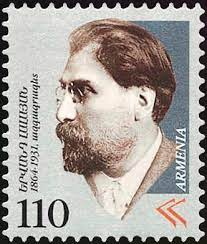Yervand Lalayan belonged to a generation of scholars who, starting in the mid-nineteenth century, was instrumental in the discovery and scholarly study of the Armenian presence in its historical territory, and left a huge legacy of cultural studies to the next generations.
He was born on March 25, 1864, in Alexandropol (nowadays Gyumri). In 1885 he graduated from the Nersisian School in Tiflis (nowadays Tbilisi) and worked in Akhaltskha, Akhalkalak, and Alexandropol as a teacher. In 1894, after graduating from the School of Social Sciences of the University of Geneva, he received a doctorate in Social Sciences and afterwards worked for six months researching at the Mekhitarist monastery of Vienna. Upon his return to the Caucasus, he taught at the Shushi Diocesan School in Artsakh in 1895-1897 along with the best scholarly minds of the time, such as Manuk Abeghian, Toros Toramanian, Hrachia Acharian, Leo, Levon Melikset-Bek, Stepan Lisitsyan, Khachik Samuelian, and others. In 1896 he launched Azgagrakan Handes (“Ethnographic Journal”), which became a premier source for Armenian ethnology, folklore, and archaeology. The journal was later moved to Tiflis and published without interruptions until 1916.
Lalayan was a prolific collector of ethnological and folkloric material, publishing many monographs about different regions of historical Armenia. He collected thousands of tales, fables, and proverbs. He also carried extensive archaeological excavations in different regions of the Republic of Armenia. In order to present the Armenian material culture to the general public, Lalayan published three photo albums dedicated to the monuments of Vayots Dzor, Vaspurakan and New Bayazet, with explanations in Armenian, Russian, and French.
In Tiflis, Lalayan organized the Ethnographic Publishing Company (1900) and the Armenian Ethnographic Society (1906), which soon opened a museum. Upon an invitation from Nikol Aghbalian, minister of Education of the first Republic of Armenia, Lalayan moved to Yerevan as the head of the newly founded State History Museum, which he would continue directing throughout the Soviet period until 1927. He published his last book, “Excavations of Tombs in Soviet Armenia” in 1931. He passed away on February 24 of the same year.

